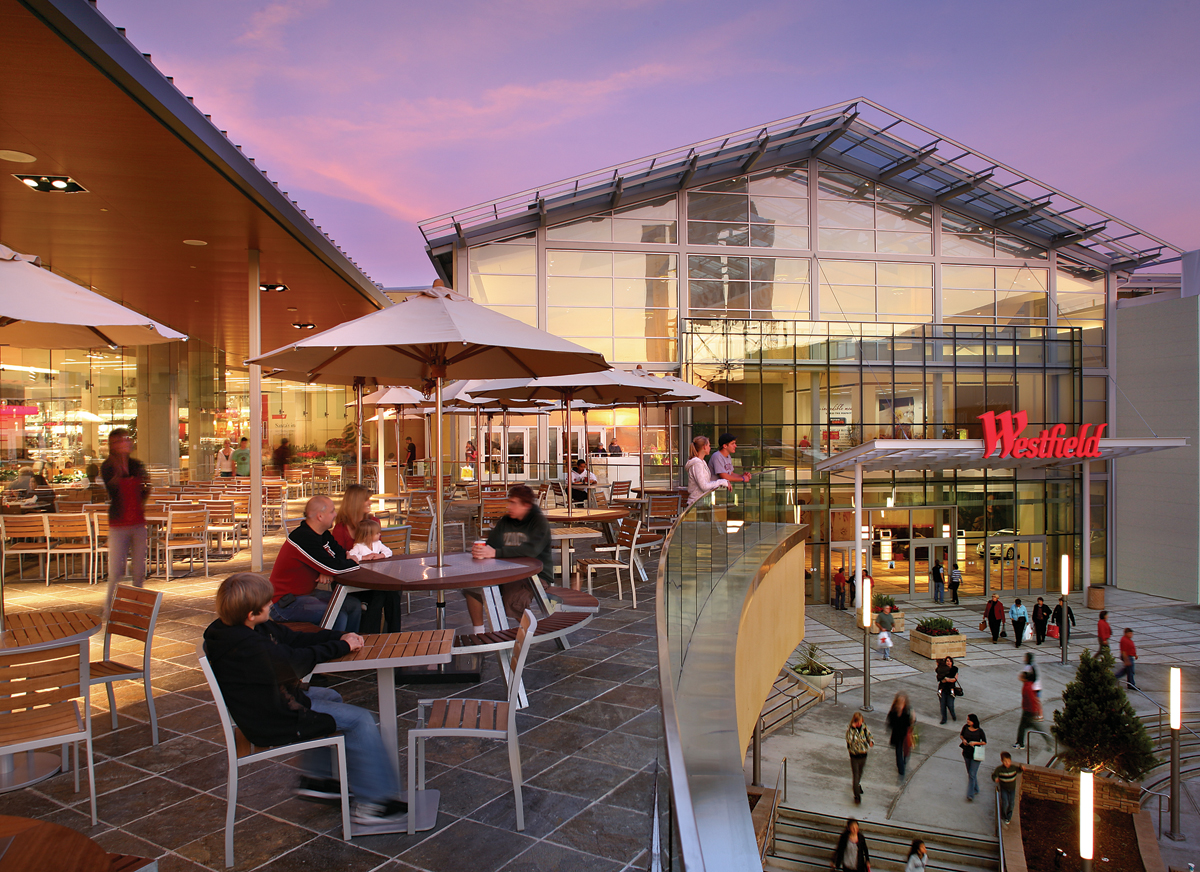When The Village at Westfield Topanga, a $350 million, 444,744-sf retail complex, opens in September, it will become the third shopping mall that developer Westfield has built at Warner Center in Century City, Calif.
The three malls—the other two being Topanga and Promenade—will have a total of 350 shops. The open-air Village will feature home-furnishing tenants, 15 restaurants, and a 146,000-sf Costco Wholesale as an anchor.
The trio of malls will offer a robust menu of lifestyle and entertainment choices that runs the gamut from the UCLA Health & Wellness Center to spaces for arts and music events. Shoppers will be able to hop from mall to mall on shuttle buses. “We are servicing customers in a more complete way,” says Larry Green, Westfield’s SVP of U.S. Development.
Five ingredients of successful mall design
1. Use design to engrain the “Wow!” factor into the mall’s brand.
2. Expand common spaces to create more points of convergence and grandeur.
3. Add “live/work” to give purpose to malls.
4. Don’t count on retail or anchors alone to drive traffic.
5. Close the dreaded Digital Divide.
Entertainment, dining, and leisure are the nutrients that are enriching undernourished retail centers, says Stantec’s Daniel Aizenman, LEED AP, a Principal and Practice Leader for Visioning, Brands and Experience. They give consumers a reason to get off their duffs and get out to the mall, instead of shopping online.
Also see: BD&C’s ranking of the 2020 Giants in retail
“Whether they research online and purchase in-store, purchase online and ship to store, or use a variety of other online and brick-and-mortar combinations, consumers just want the path to purchase to be as easy as possible, with excellent customer service at every step along the way,” says Cindy Radney, JLL’s Vice President of National Retail Property Services Marketing. The industry’s term for this mix of purchasing modes: “omni-channel retailing.”
Where retail centers, especially giant regional malls, fit into this equation is not clear, as the modern American mall continues to go through a crisis of confidence. In the past eight years, only two enclosed regional malls opened in the U.S. At least two-dozen others have closed since 2010, according to Green Street Advisors.
The traditional mall is fast becoming “a historical anachronism” desperately in need of reinvention, says Rick Caruso, CEO of retail developer Caruso Affiliated. This from someone whose signature project, The Grove at Farmers Market, in Los Angeles, is still one of the most copied outdoor retail, food, and entertainment centers in the U.S., 13 years after it opened.
It’s not just the Internet that is crowding enclosed malls, which have been yielding ground to a host of competing shopping formats: outlet malls, outdoor malls, lifestyle centers, even the much-maligned strip center. Over the past two years, Brixmor Property Group, which specializes in grocery-anchored strips, has convinced numerous enclosed-mall-inclined tenants to consider strips. Brixmor, with 552 properties, has written 150 anchor leases over the past two years, says SVP of Marketing Kristen Moore.
“We are in the midst of a genuine paradigm shift of what a retailer is and does,” says Jamie Pett, AIA, Principal, JP2 Architects. Last year, the International Council of Shopping Centers recognized JP2 and its partners for revitalizing the 1.8-million-sf Southdale Center, in Edina, Minn., a “Frankenstein monster” (in Pett’s words) of disparate sections and aesthetic styles that this Building Team successfully unified. Southdale will celebrate its 60th anniversary next year.
With less new mall construction taking place, AEC firms are helping owners and developers rethink their existing properties: how to make their common areas more inviting and multifunctional, their infrastructure more supportive of fast-changing technologies, and their retail tenants more appealing to aspirational shoppers.
“I don’t think there’s a retailer or mall owner out there that doesn’t realize it needs to change pretty rapidly,” says MJ Munsell, IIDA, Principal and Retail Design Lead, MulvannyG2 Architecture. Here’s how some of the leaders in the field are making those changes.
1. Use design to engrain the “Wow!” factor into the mall’s brand.
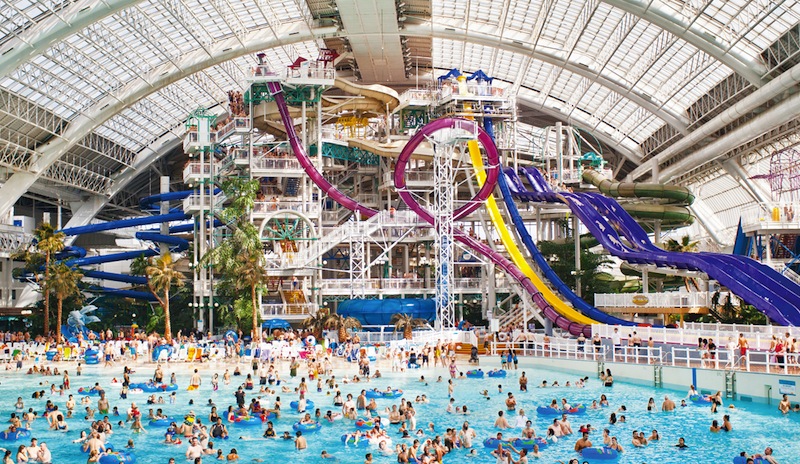
No mall is complete these days without some form of entertainment and leisure. And no mall owner takes that maxim as far over the top as Triple Five Worldwide, whose properties include the 5.3-million-sf West Edmonton Mall in Canada, which recently got approval to add a 150,000-sf wing. Its renowned water park features the world’s largest indoor wave pool and 17 waterslides. Photo: courtesy Triple Five Worldwide
As mall owners reposition their properties to make them essential, if not preferred, destination points, they must keep in mind that shopping alone doesn’t cut it as an enticement. “Shopping centers need to be about place, experience, and convenience,” says David Chilinski, AIA, Partner with architectural firm Prellwitz Chilinski Associates. Shoppers, he says, have to associate the retail experience with their personal brand.
David Glover, Principal and Firmwide Director of Retail Centers at Gensler, is convinced that the next generation of shopping centers must excel in four areas: extraordinary design, hyper levels of service, the internationalization of brands, and the decentralization of food and beverage.
On the design front, retailers want that “Wow!” factor that calls attention to their spaces. Last October, footwear retailer Asics opened an outlet in New York’s Times Square that includes a full-sized subway car, circa 1961. Audio giant Harman Kardon’s flagship showroom on Madison Avenue in New York, built by Shawmut Design and Construction and opened in 2013, features a living room-like lounge where customers can listen to music on a $200,000 stereo system.
Artwork has become an increasingly popular design element in shopping centers. Westfield has partnered with Cal State Northridge University’s radio station, street muralist Elkpen (real name Christian Kasperkovitz), and UCLA’s School of the Arts and Architecture to create art and music events at the Village. MulvannyG2’s Munsell singles out Nordstrom for the way it adeptly coordinates in-store art with various products and departments.
Artwork is interspersed throughout the 773,000-sf Fashion Outlets of Chicago, primarily to lure Millennial shoppers, says Lori Mukoyama, Senior Associate Vice President and Retail Environments Studio Leader with RTKL, FOC’s lead design firm. This is the first ground-up enclosed mall to be built in the Chicago market in more than a decade. Before it opened near O’Hare International Airport in August 2013, the only outlet malls in the region were in Aurora and Gurnee, more than 40 miles from the Loop.
2. Expand common spaces to create more points of convergence and grandeur.
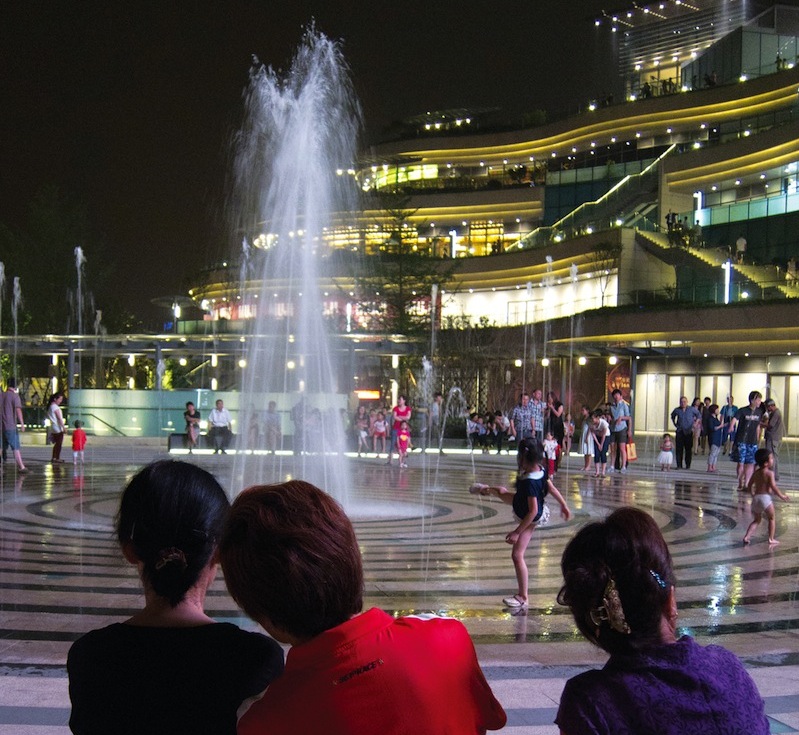
Common spaces are big draws for retail centers like China’s Chengdu MixC, whose water feature attracts all ages. Photo courtesy Callison
Mall transformation needs to include much more common space for events, says Natina James, AIA, LEED AP, a retail specialist and Project Architect with RSP Architects, Minneapolis, Minn. Entrances and vesibules have gotten taller and grander, as if to suggest that shoppers are walking into a marvelously different environment. Standout entrances, in fact, have become something of a trademark for Simon Property Group, the industry’s largest owner/operator, which last year spent $500 million on renovations and additions.
Owners favor a lighter, neutral color palette and more natural light for these common spaces in their mall renovations. When PCL Construction Services worked on remodeling the South Avenue side of Mall of America in Bloomington, Minn., it replaced darker finishes with white tiles and walls and clear-glass handrails, says PCL’s District Manager Mike Headrick.
Centralized food courts are also emerging as pivot points in rebooting a mall’s brand. Developer/owner Triple Five Worldwide Group is spending $5 million for the food court alone in American Dream, its $4 billion, 3.1-million-sf retail/entertainment leviathan under construction in East Rutherford, N.J. A major element in the Southdale Center revitalization was relocating its food court under a new, expansive skylight.
In Surrey, B.C., design firm Callison relocated the food court in the regional shopping mall Guildford Town Centre closer to the street to break down the perception of the mall as a fortress. “Now, it’s more approachable,” says Callison’s Steve Dwoskin, AIA, Principal.
Sometimes, more radical measures are needed to save a struggling retail complex. The Chestnut Hill (Mass.) Shopping Center, built in 1949, served an upscale Boston suburban market whose current household income averages $155,000. The storefronts were badly outdated, and parking was inconveniently located in the rear.
Prellwitz Chilinski's redesign surgically extracted a few buildings, notably a Macy’s, and converted three structures into a 378,555-sf open-air retail and dining venue with a movie theater, a fitness center, and 60,000 sf of offices. “We made it into a kind of village, with trees, nice paving, and [better] lighting,” says Chilinski.
The owner, WS Development, leased a road that runs parallel to Route 9 and created a one-way street with angled parking and new frontage. The 41-store complex, renamed The Street, recently won a Gold medal in the ICSC U.S. Design and Development Awards.
3. Add “live/work” to give purpose to malls.
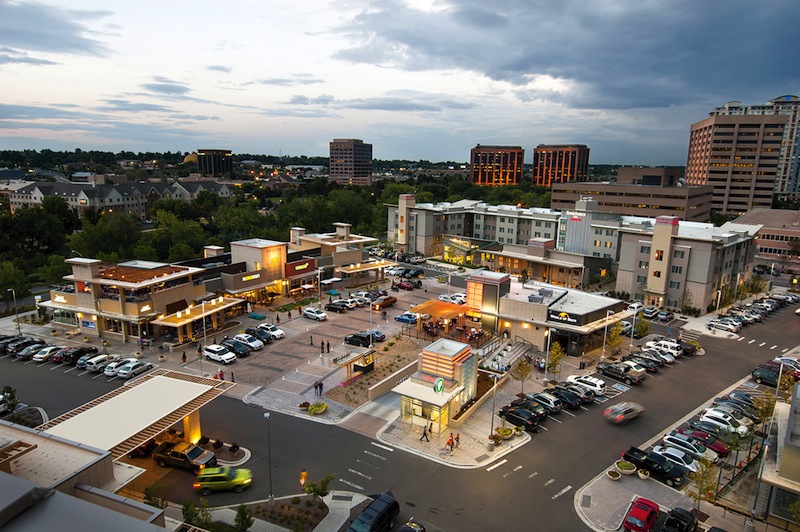
More developers are combining retail with live/work components. CitySet, a seven-acre mixed-use development in Glendale/Cherry Creek, Colo., started as a hotel remodel but became a 250,000-sf open-air plaza blending hotels, restaurants, and retail. Photo courtesy Stantec
Adding live/work elements to the shopping experience—yet another trend in mall resuscitation—has its roots in the work of Victor Gruen, Southdale Center’s original architect. Gruen envisioned retail malls that incorporated schools, offices, apartments, and homes to create a total environment.
While Gruen’s ideal was not implemented at Southdale, the concept is getting a new lease on life among today’s mall developers. Simon Property Group, Southdale Center’s owner, has been working with a residential builder to add 300 rental apartments on what was once a nearby parking lot.
Jeff Gunning, AIA, LEED AP, SVP with RTKL, points out that Macerich, the California-based REIT, was primarily a mall developer until it purchased Tyson’s Corner Center in Fairfax County, Va., three years ago. “Now, its mantra is mixed use,” he says of the developer. The buildout of one of Northern Virginia’s top retail destinations will include three residential towers, along with an office building.
Also see: Mall redevelopers could result in property devaluation in 2021
One of the few regional malls to open in the past few years, the Callison-designed City Creek Center, in Salt Lake City, includes 500 residential units within its 23 acres. In Watertown, Mass., Prellwitz Chilinski Associates redesigned a retail mall called The Arsenal Project, which it densified by adding 400 apartments and condos. The complex straddles a road near the Charles River that is being developed into public and recreational space.
Gensler’s Glendale 180, five miles southeast of Denver, is being designed as an outdoor mixed-use development anchored by retail. The live/work complex “uses the concept of ‘weaving’ to communicate an urban form, where culture, nature, and leisure weave, layer, overlap, and fuse to produce a distinct sense of place,” says Glover.
In Mexico, Stantec has worked on several retail malls that Aizenman says are “true centers of community.” These include Gran Patio Santa Fe, a 2.1-million-sf mixed-use vertical power center that Aizenman says appeals to all social and income classes in the area.
As Ian Thomas, a retail consultant in Vancouver, B.C., puts it, “No longer are these [malls] merely town centers, but often they are the center of town, where public space can be the new anchor.”
4. Don’t count on retail or anchors alone to GENERATE traffic.
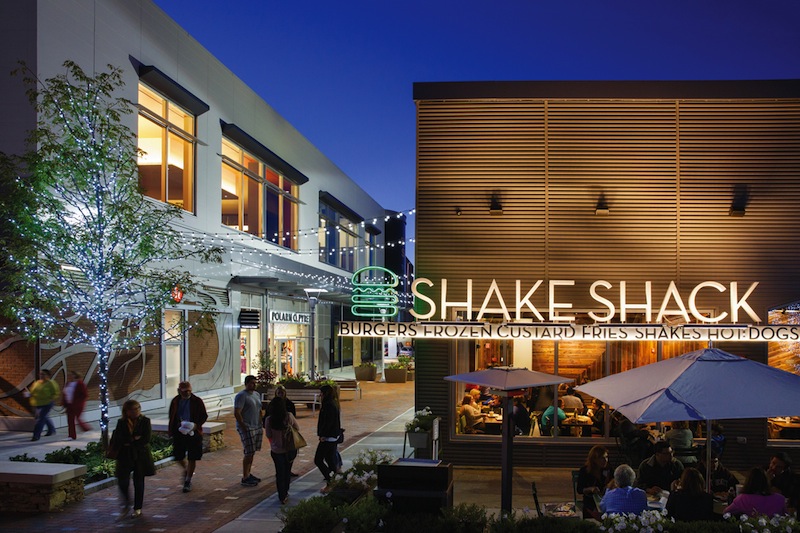
Providing customers with dining options has become an important key to the success of shopping centers like the award-winning mall conversion known as The Street, in Chestnut Hill, Mass. Photo: Michael Blanchard
Retail has become a secondary, even tertiary, traffic driver for many malls. Simon Property Group’s Les Morris says that his company’s Mills properties—hybrids of full-scale malls and outlets—feature such entertainments as LegoLand, aquariums, and Medieval Times. Simon’s 1.8-million-sf Florida Mall, in Orlando, will soon include The Crayola Experience, a 70,000-sf space that offers 25 hands-on activities for children, even the ability to create their own personalized crayons.
Derek Barker, a Managing Director with London-based architecture firm Haskoll, notes that in 2000 his firm designed a mall in which 10% of the leased space was earmarked for leisure and dining. “Everyone thought that was over the top,” he says.
But no one blinked when, in 2011, he says, Westfield opened its Westfield Stratford City mall, in East London near Olympic Park, with 25% of its leased space devoted to dining and leisure, including Aspers, the U.K.’s first supercasino.
“It is clear that we are heading for a de-emphasis of the anchor store as the main draw to a center,” says JLL in its Fourth Quarter 2014 Retail Outlook. Thomas sees the advent of lifestyle centers as part of a larger strategy to create Main Street developments with everything from outdoor fire pits to performing arts centers, where the retail component becomes more or less supplemental.
Retail stores become the backdrop when E! News films weekly live segments at The Grove at Farmers Market. Triple Five’s American Dream will include a ski slope, Ferris wheel, and a 225,000-sf water park sponsored by DreamWorks. Movie theaters in malls now routinely feature plush reclining seats, concierge food service, and lobbies like the Ritz-Carlton, says Thomas.
How far mall owners will take this trend is anyone’s guess. But Rodolfo Farber, Partner/Director of Jaime Partners, a project management company that specializes in restaurants, cautions those owners about larding their tenant mix with dining and entertainment at the expense of retail. “There needs to be a balance,” he says. “Restaurants are risky, and if they fail it’s hard to put a different kind of tenant into that space.”
One type of retail that malls aren’t giving short shrift to is luxury, even in outlet centers. “Quality is important, regardless of spending power, because customers’ expectations have changed,” says Haskoll’s Barker. Gunning adds that malls are pursuing aspirational shoppers who, even during the recession, “found ways to shop both Target and Neiman Marcus.”
Callison’s Dwoskin points to two outlet malls—The Mills at Jersey Gardens, in Elizabeth, N.J., and The Outlet Collection Seattle, in Auburn, Wash.—whose fates turned for the better once they made more high-end brands available to customers. “The magic was in the re-leasing,” he says.
This is not to say that luxury and middle class retail can’t coexist. Fashion Outlets in Chicago assigns its luxury tenants to the second floor, and middle-class retailers like Disney and Nike to its first. Triple Five’s EVP/COO Jeff Sheckter says that before his company starts renovating or constructing a megamall, it sorts out the tenant mix to determine designs that will complement those tenants’ brands.
5. Close the dreaded Digital Divide.
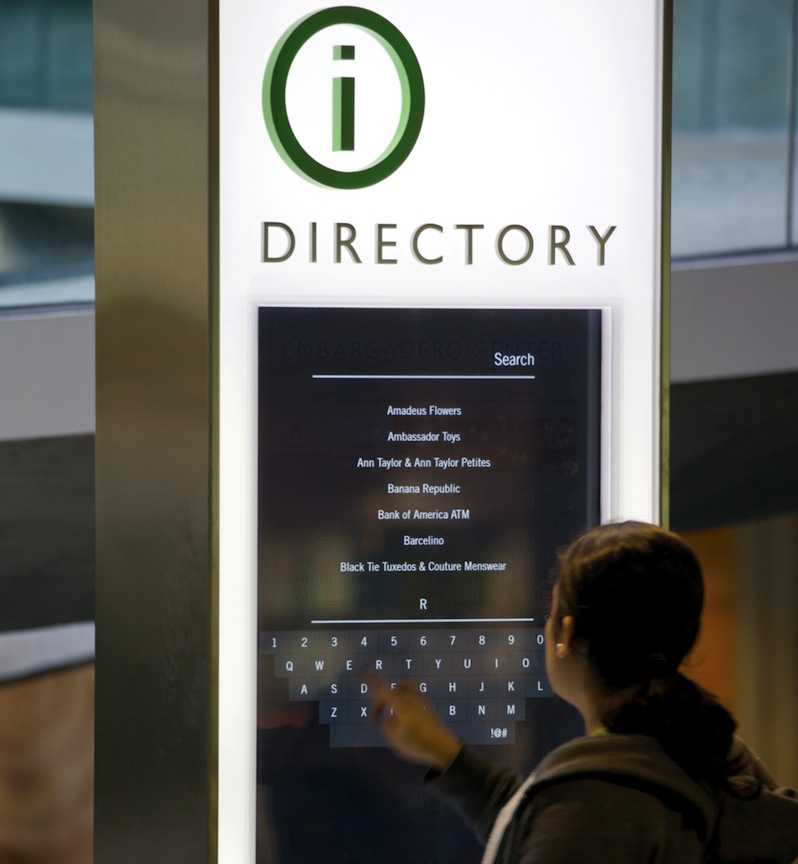
Technology is providing more ways for shopping centers to connect meaningfully with tech-savvy customers. At the Embarcadero Center in San Francisco (above), RTKL revamped the mall with an entirely digital navigation and media program. Corporate Sign Systems was the engineer on the project. The owner/developer is Boston Properties. Photo: © RTKL / David Whitcomb
“Technology is reshaping the way we shop, share information, experience a place, and even the way we bestow status,” says Gensler’s Glover.
Consequently, mall owners need to accommodate customers who are seeking avenues to buy and receive merchandise in the most convenient ways possible. West Marine, a boating hardware retailer with 270 locations in North America, calls its website “our largest store.” At the same time, MulvannyG2 has redesigned West Marine stores to lure customers into its brick-and-mortar outlets by transitioning into a lifestyle brand with a wider variety of “life on the water” apparel, accessories, and gifts.
The quandary for malls and their retail tenants is how to combine the ease of shopping online with the touch and feel of the brick-and-mortar experience. Technology is providing some solutions.
Apps and social media platforms are hugely important for malls to enter their customers’ communal orbits, according to AEC experts we consulted. So-called beacon technology is being used to inform mall shoppers about fast-breaking promotions and events. The technology can even direct shoppers to specific products in stores. (See www.BDCnetwork.com/beacon for more on this technology.)
Mall tenants are using technology to connect digitally with customers. Nordstrom and Macy’s are two prominent mall anchors that have found ways to integrate mobile technology into their stores’ shopping experience at the checkout and in accessing inventory. Macy’s stores now accept returns of online purchases, and have had success trading up those shoppers to higher-priced products.
Industry sources point to retailers like UNIQLO and Burberry, which have been testing interactive mirrors for customers to see how they might look in clothing without having to try on the merchandise.
Department store chain Kohl’s spent about $1 billion on technology over the last three years and intends to spend a billion more through 2017. It’s focusing on collecting data on customer purchasing habits to bridge the online experience into its stores.
“Let’s imagine: You walk into a Kohl’s store, your app is on, we can now surprise you with inventory that we have at that store that you may not have known about,” says Ken Bonning, Kohl’s Senior EVP of IT, Logistics, and Store Planning.
Last December, Simon Property Group’s Stanford Shopping Center, in Palo Alto, Calif., unveiled the “Connected Mall,” an interactive directory Simon developed with eBay’s Retail Innovation Division. A 72-inch touchscreen allows shoppers to view 3D mall maps, search for event schedules, services, and discounts; and download directions to stores onto their smartphones.
Triple Five and Westfield are now testing software that would allow shoppers to remotely reserve mall parking.
Technology upgrades can place physical demands on shopping environments. Mall renovations often require significant physical changes to accommodate IT and data systems that may not have existed when the mall was built. PCL recently converted an old bookstore into a Verizon outlet that needed more power to operate. PCL’s Headrick says that technology upgrades alone consumed a third of the project budget.
Robust, free WiFi is “a bare minimum” for any mall that wants to be relevant to tech-savvy shoppers, says Westfield’s Green. Charging stations for mobile devices and interactive kiosks are also becoming commonplace.
Triple Five’s Sheckter says his company’s $40 million renovation of its 5.3-million-sf West Edmonton Mall, in Alberta, which opened in 1981, involved ripping out much of its backbone to install new electrical, cable, phone lines, gimbal lighting, texting stations, and triangulated WiFi.
LONG LIVE THE MALL
For all the talk about the death of regional malls, the opening of a new shopping center still generates buzz. Hawaii Governor David Ige turned out, shovel in hand, for the March groundbreaking of Ka Makana Ali`i, the first regional mall to be built in Oahu in three decades. The state expects to generate nearly $1 billion in revenue over its 65-year land lease agreement with DeBartolo Development, the 1.4-million-sf mall’s owner.
Triple Five recently announced plans to build the largest mall in the country, a second American Dream on 200 acres in northwestern Miami-Dade, Fla. It will feature a submarine and sea lions.
Simon Property Group is building new Premium Outlets in Charlotte, Minneapolis–St. Paul, Montreal, Tucson, Tampa, and Gloucester Township, N.J. The developer’s new 500,000-sf shopping center in Fort Worth, The Shops at Clearfork, will have 100 high-end specialty stores, a premium theater, and restaurants when it opens in 2017. Simon is also renovating or expanding 27 existing malls this year.
Those developments are further signs of the heightened competitiveness in an industry where once-reliable anchors and tenants like Macy’s, Sears, RadioShack, Staples, and JC Penney have been closing stores right and left.
Mall owners continue to assess shopping patterns for clues about how to reshape their malls to get more customers into their buildings. They will be looking to corral more unconventional tenants like health clubs, nightclubs, walk-in clinics, even car dealerships. Southdale Center has a Mini dealership; last year, Tesla Motors debuted its “gallery” in the Mall at Short Hills in Milburn, N.J.
A Callison-designed project, the University Village Shopping Center, in Seattle, incorporates the 7,500-sf Virginia Mason University Village Medical Center, with a pediatrics department. “Parents who bring their kids there are also the sweet spot for the mall,” says Callison’s Dwoskin.
Westfield is focusing on expanding events like concerts and ice-skating sessions to enhance the drawing power of its malls. But Green, Westfield’s SVP, concedes that keeping its properties fresh and exciting will be easier said than done. “The bar continues to be raised,” he says.
Related Stories
| Feb 11, 2011
Chicago high-rise mixes condos with classrooms for Art Institute students
The Legacy at Millennium Park is a 72-story, mixed-use complex that rises high above Chicago’s Michigan Avenue. The glass tower, designed by Solomon Cordwell Buenz, is mostly residential, but also includes 41,000 sf of classroom space for the School of the Art Institute of Chicago and another 7,400 sf of retail space. The building’s 355 one-, two-, three-, and four-bedroom condominiums range from 875 sf to 9,300 sf, and there are seven levels of parking. Sky patios on the 15th, 42nd, and 60th floors give owners outdoor access and views of Lake Michigan.
| Feb 11, 2011
Grocery store anchors shopping center in Miami arts/entertainment district
18Biscayne is a 57,200-sf urban retail center being developed in downtown Miami by commercial real estate firm Stiles. Construction on the three-story center is being fast-tracked for completion in early 2012. The project is anchored by a 49,200-sf Publix market with bakery, pharmacy, and café with outdoor seating. An additional 8,000 sf of retail space will front Biscayne Boulevard. The complex is in close proximity to the Adrienne Arsht Center for the Performing Arts, the downtown Miami entertainment district, and the Omni neighborhood, one of the city’s fast-growing residential areas.
| Feb 11, 2011
Apartment complex caters to University of Minnesota students
Twin Cities firm Elness Swenson Graham Architects designed the new Stadium Village Flats, in the University of Minnesota’s East Bank Campus, with students in mind. The $30 million, six-story residential/retail complex will include 120 furnished apartments with fitness rooms and lounges on each floor. More than 5,000 sf of first-floor retail space and two levels of below-ground parking will complete the complex. Opus AE Group Inc., based in Minneapolis, will provide structural engineering services.
| Feb 11, 2011
Green design, white snow at Egyptian desert retail complex
The Mall of Egypt will be a 135,000-sm retail and entertainment complex in Cairo’s modern 6th of October district. The two-story center is divided into three themed zones—The City, which is arranged as a series of streets lined with retail and public spaces; The Desert Valley, which contains upscale department stores, international retailers, and a central courtyard for music and other cultural events; and The Crystal, which will include leisure and entertainment venues, including a cinema and indoor snow park. RTKL is designing the massive complex to LEED Silver standards.
| Jan 25, 2011
AIA reports: Hotels, retail to lead U.S. construction recovery
U.S. nonresidential construction activity will decline this year but recover in 2012, led by hotel and retail sectors, according to a twice-yearly forecast by the American Institute of Architects. Overall nonresidential construction spending is expected to fall by 2% this year before rising by 5% in 2012, adjusted for inflation. The projected decline marks a deteriorating outlook compared to the prior survey in July 2010, when a 2011 recovery was expected.
| Jan 21, 2011
Harlem facility combines social services with retail, office space
Harlem is one of the first neighborhoods in New York City to combine retail with assisted living. The six-story, 50,000-sf building provides assisted living for residents with disabilities and a nonprofit group offering services to minority groups, plus retail and office space.
| Jan 21, 2011
Revamped hotel-turned-condominium building holds on to historic style
The historic 89,000-sf Hotel Stowell in Los Angeles was reincarnated as the El Dorado, a 65-unit loft condominium building with retail and restaurant space. Rockefeller Partners Architects, El Segundo, Calif., aimed to preserve the building’s Gothic-Art Nouveau combination style while updating it for modern living.
| Jan 19, 2011
Baltimore mixed-use development combines working, living, and shopping
The Shoppes at McHenry Row, a $117 million mixed-use complex developed by 28 Walker Associates for downtown Baltimore, will include 65,000 sf of office space, 250 apartments, and two parking garages. The 48,000 sf of main street retail space currently is 65% occupied, with space for small shops and a restaurant remaining.
| Jan 7, 2011
BIM on Target
By using BIM for the design of its new San Clemente, Calif., store, big-box retailer Target has been able to model the entire structural steel package, including joists, in 3D, chopping the timeline for shop drawings from as much as 10 weeks down to an ‘unheard of’ three-and-a-half weeks.
| Jan 7, 2011
Mixed-Use on Steroids
Mixed-use development has been one of the few bright spots in real estate in the last few years. Successful mixed-use projects are almost always located in dense urban or suburban areas, usually close to public transportation. It’s a sign of the times that the residential component tends to be rental rather than for-sale.


